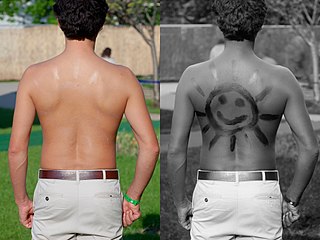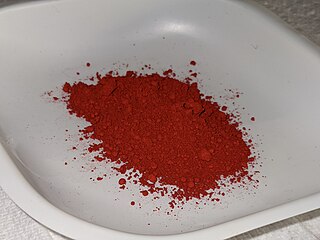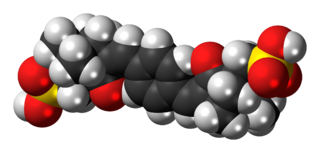
Sunscreen, also known as sunblock or sun cream, is a photoprotective topical product for the skin that helps protect against sunburn and prevent skin cancer. Sunscreens come as lotions, sprays, gels, foams, sticks, powders and other topical products. Sunscreens are common supplements to clothing, particularly sunglasses, sunhats and special sun protective clothing, and other forms of photoprotection.

Sun tanning or tanning is the process whereby skin color is darkened or tanned. It is most often a result of exposure to ultraviolet (UV) radiation from sunlight or from artificial sources, such as a tanning lamp found in indoor tanning beds. People who deliberately tan their skin by exposure to the sun engage in a passive recreational activity of sun bathing. Some people use chemical products which can produce a tanning effect without exposure to ultraviolet radiation, known as sunless tanning.

Indoor tanning involves using a device that emits ultraviolet radiation to produce a cosmetic tan. Typically found in tanning salons, gyms, spas, hotels, and sporting facilities, and less often in private residences, the most common device is a horizontal tanning bed, also known as a sunbed or solarium. Vertical devices are known as tanning booths or stand-up sunbeds.

Dihydroxyacetone, also known as glycerone, is a simple saccharide with formula C
3H
6O
3.

β-Carotene (beta-carotene) is an organic, strongly colored red-orange pigment abundant in fungi, plants, and fruits. It is a member of the carotenes, which are terpenoids (isoprenoids), synthesized biochemically from eight isoprene units and thus having 40 carbons.

Astaxanthin is a keto-carotenoid within a group of chemical compounds known as terpenes. Astaxanthin is a metabolite of zeaxanthin and canthaxanthin, containing both hydroxyl and ketone functional groups. It is a lipid-soluble pigment with red coloring properties, which result from the extended chain of conjugated double bonds at the center of the compound. The presence of the hydroxyl functional groups and the hydrophobic hydrocarbons render the molecule amphiphilic.

Canthaxanthin is a keto-carotenoid pigment widely distributed in nature. Carotenoids belong to a larger class of phytochemicals known as terpenoids. The chemical formula of canthaxanthin is C40H52O2. It was first isolated in edible mushrooms. It has also been found in green algae, bacteria, crustaceans, and bioaccumulates in fish such as carp, golden grey mullet, seabream and trush wrasse.

D-Erythrulose (also known as erythrulose) is a tetrose carbohydrate with the chemical formula C4H8O4. It has one ketone group and so is part of the ketose family. It is used in some self-tanning cosmetics, in general, combined with dihydroxyacetone (DHA).

Ecamsule is an organic compound which is added to many sunscreens to filter out UVA rays. It is a benzylidene camphor derivative, many of which are known for their excellent photostability.

Carotenosis is a benign and reversible medical condition where an excess of dietary carotenoids results in orange discoloration of the outermost skin layer. The discoloration is most easily observed in light-skinned people and may be mistaken for jaundice. Carotenoids are lipid-soluble compounds that include alpha- and beta-carotene, beta-cryptoxanthin, lycopene, lutein, and zeaxanthin. The primary serum carotenoids are beta-carotene, lycopene, and lutein. Serum levels of carotenoids vary between region, ethnicity, and sex in the healthy population. All are absorbed by passive diffusion from the gastrointestinal tract and are then partially metabolized in the intestinal mucosa and liver to vitamin A. From there they are transported in the plasma into the peripheral tissues. Carotenoids are eliminated via sweat, sebum, urine, and gastrointestinal secretions. Carotenoids contribute to normal-appearing human skin color, and are a significant component of physiologic ultraviolet photoprotection.
Photoprotection is the biochemical process that helps organisms cope with molecular damage caused by sunlight. Plants and other oxygenic phototrophs have developed a suite of photoprotective mechanisms to prevent photoinhibition and oxidative stress caused by excess or fluctuating light conditions. Humans and other animals have also developed photoprotective mechanisms to avoid UV photodamage to the skin, prevent DNA damage, and minimize the downstream effects of oxidative stress.

Biological pigments, also known simply as pigments or biochromes, are substances produced by living organisms that have a color resulting from selective color absorption. Biological pigments include plant pigments and flower pigments. Many biological structures, such as skin, eyes, feathers, fur and hair contain pigments such as melanin in specialized cells called chromatophores. In some species, pigments accrue over very long periods during an individual's lifespan.

Indoor tanning lotions accelerate the tanning process, by promoting the production of melanin. Increasing blood flow to the skin is a proposed mechanism, which may in turn stimulate production of melanin by melanocytes. Historically, indoor tanning lotions have contained no sunscreen and offer no protection from the sun. However, many tanning lotions currently contain sunscreen. Unlike sunless tanning lotions, these are designed for use with an ultraviolet source such as a tanning bed or booth.
Tanning activators are chemicals that increase the effect of UV-radiation on the human skin.

Afamelanotide, sold under the brand name Scenesse, is a medication used to prevent phototoxicity and to reduce pain from light exposure for people with erythropoietic protoporphyria. It is a melanocortin 1 receptor (MC1-R) agonist and a synthetic peptide and analogue of α-melanocyte stimulating hormone. It is administered as subcutaneous implant.

Sunburn is a form of radiation burn that affects living tissue, such as skin, that results from an overexposure to ultraviolet (UV) radiation, usually from the Sun. Common symptoms in humans and other animals include red or reddish skin that is hot to the touch or painful, general fatigue, and mild dizziness. Other symptoms include blistering, peeling skin, swelling, itching, and nausea. Excessive UV radiation is the leading cause of (primarily) non-malignant skin tumors, which in extreme cases can be life-threatening. Sunburn is an inflammatory response in the tissue triggered by direct DNA damage by UV radiation. When the cells' DNA is overly damaged by UV radiation, type I cell-death is triggered and the tissue is replaced.

Photoaging or photoageing is a term used for the characteristic changes to skin induced by chronic UVA and UVB exposure. Tretinoin is the best studied retinoid in the treatment of photoaging.
Bain de Soleil was a brand of sunscreen that was produced by Bayer. It was affiliated with the Coppertone brand. The name Bain de Soleil is French for "sun bathing." The brand used the slogan "Welcome to a place more colorful." In the 1970s and 1980s, the brand used the slogan "Bain de Soleil, for the St. Tropez tan." The brand was discontinued in December 2019.

The Sunscreen Innovation Act is a 2014 law that amended the Federal Food, Drug, and Cosmetic Act to establish an expedited process for the review and approval of over-the-counter (OTC) sunscreens. The US Food and Drug Administration (FDA) had not approved a new active ingredient in sunscreen since 1999, despite some sunscreens having been approved and used overseas for a decade. The new law gave the FDA one year to respond to the existing backlog of sunscreen ingredient approval requests, and then 18 months to reply to any future applications.
















